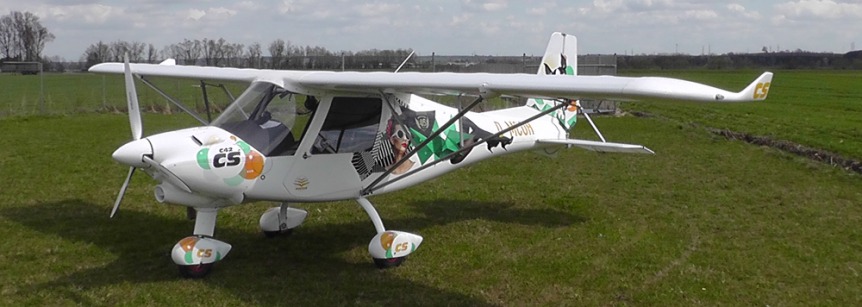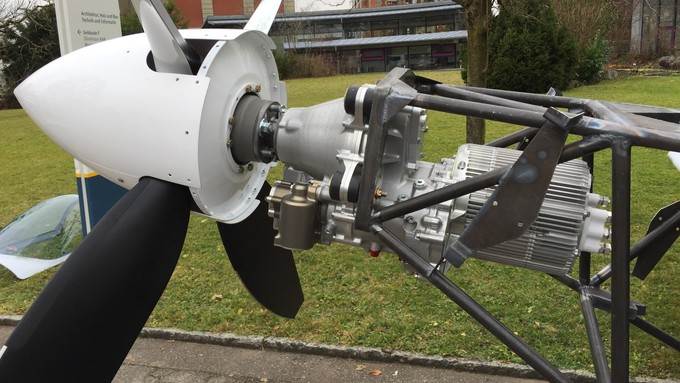Relatively unknown to American pilots, Germany’s largest ultralight aircraft manufacturer, Comco Ikarus in Mengen, was able to announce the first flight of its successful two- seater C42 / CS as an electric version just before the start of AERO, the annual aircraft exposition in Friedrichshafen. Comco’s C42 CS forms the basis for the electric version. The avgas-powered version flies with either an 80-horsepower or 100-horsepower Rotax engine, the electric version with a 32-kilowatt (50 horsepower) electric motor from Geiger Engineering. Geiger’s power package includes their dedicated controller, control lever, and monitoring instrument. Four battery packs, 15 kilograms (33 pounds) each, power the prototype, but production versions will have six packs, enabling flight times of up to 90 minutes. The first electric flight was completed by Comco Ikarus’ managing director Horst Lieb on April 15, 2018. Comco notes, “The complete electrical unit with batteries is only marginally more expensive than the combustion version.” The aircraft, with a span of 8.71 meters (28.6 …
Verdego Aero – Another Variant on VTOL Travel
A Controversy for Starters Skeptics abound concerning the current spate of vertical takeoff and landing (VTOL) machines. The latest entry in the competition comes from the trio of Erik Lindbergh, Eric Bartsch, and Pat Anderson of Embry-Riddle Aeronautical University. Their Verdego eight-rotor machine looks a bit like the Airbus A3 Vahana, but has pusher, rather than puller, propellers on the rear wing. On his Linked In page, Bartsch jumps into an ongoing fray with his article, “The Inevitability of Short-Range Urban Aviation – Why I’m Betting Against the “Flying Uber” Skeptics.” It takes aim at the opposing point of view in “Going Direct: On the Insanity of Flying Ubers,” by Plane & Pilot writer Robert Goyer. To shorten the two arguments to their most primal levels, Eric Bartsch thinks sky taxis are coming and are inevitable. Goyer thinks the idea is insane and not supported by even basic physics or available mechanical systems. He doesn’t acknowledge an advantage to having …
Smartflyerchallenge – Europe’s First Fly-In for Electric Powered Aircraft
Air meets have been an important part of aviation history, bringing pilots, planes nad the public together in a symbiotic gathering. This was true in aviation’s genesis; things gaining a tremendous impetus with air meets throughout Europe and America following Wilbur Wright’s 1908 public demonstrations near Le Mans, France. René Maier, ex-Colonel of the Swiss Army and current President of the newly formed organization team for an annual event organized at the Grenchen Regional Airport, has announced the SmartFlyer Challenge, touted as the first fly-in for electric aircraft. The event, to be held September 9 and 10, 2017, will make Grenchen “the center of electric flight,” according to the organizers. Static and air displays of electric and hybrid-electric powered aircraft will help drive that message home. Organizers advertise at least four aircraft scheduled to appear, including an electrified Votec 221 being prepared by a group of university students at Innocampus Biel at the Bern University of Applied Sciences, Hangar 55’s Hamilton …
SmartFlyer – an Electric Four-Seater?
The people behind the Smartflyer, a Swiss design concept now under development ask, “Why does the Smartflyer look like this? With a tail-mounted electric motor, it’s a bit reminiscent of e-Genius, and also a bit like a strutless Rutan Skigull. In fact, the basic configuration has been used on many significant aircraft over the last several decades, as a segment of Smartflyer’s web site shows. As Herr Professor Dipl-Ing. Rudolf Voit-Nitschmann, Project Leader on e-Genius explained, several benefits accrue from this arrangement of aerodynamic elements. Compared to a conventional touring motor glider a substantial larger propeller-diameter can be realized without a high and consequentially heavier undercarriage. Therefore the propeller-efficiency will increase. The front body part has the aerodynamic quality of a modern glider (no vorticities and local impact pressure peaks) and thus a very small drag. The propeller is optimally protected from ground contact. Electric motors are light enough to mount on a tail and are therefore able to benefit from that placement while …
EAS IX: Dr. Seeley’s Magnum Opus
Your editor first met Dr. Brien Seeley, founder and President of the CAFE Foundation, at the Western Workshop for the Experimental Soaring Association in 2007. Dr. Seeley spoke about the CAFE Foundation and its many areas of research, including its first two Electric Aircraft Symposiums. Seven years later these events and this blog are among the few resources for people seeking information on this developing field. He spoke then about a novel idea, an aerial taxi service that would eventually become fully autonomous, hauling people on short-to-medium range trips in small, electric aircraft that would fly out of very small airports. This seemed a bit of science-fiction at the time, but Dr. Seeley has continued to promote this idea, gaining valuable allies and convincing growing numbers that this is a practical alternative to the wasteful clogs on our nation’s highways, taking their toll on time, treasure and the human spirit. At this year’s Electric Aircraft Symposium, he shared the mature …
EAS IX: Calin Gologan Talks SolarStratos
Calin Gologan, founder and CEO of PC-Aero GmbH, has many electric and solar-assisted aircraft flying right now, and is responsible for the design the Aero Electric Aircraft Company’s SunFlyer training airplane, 20 of which have been ordered by Spartan Aeronautical University. The initial Elektro One has flourished in a number of variants, including the SunFlyer, a two-seat, side-by side trainer developed with George Bye in Colorado. Another variant of that original design, Solar Stratos is destined to combine record-setting altitudes with scientific research. Its banner, “Manned Flight at the Edge of Space,” highlights the craft’s intended mission to reach 80,000 feet as its initial goal, a record that will be hard to beat. Its mission is also a research venture, with Calin serving as Chief Technology Officer of SolarStratos. The initiator of SolarStratos, Raphaël Domjan, is now paddling his way through an Arctic Passage in one of two solar-powered kayaks, accompanied by Anne Quéméré, described as a Breton sailor. Their …
Powering Imagination at the Museum of Flight
Powering Imagination, a symposium devoted to that premise and to encouraging the development of electric aviation, achieved both goals on Saturday, February 28 at Seattle’s Museum of Flight. Organized by Erik Lindbergh and Eric Bartsch, the gathering included two panel discussions and eight presentations that helped define where the world of electric flight might be heading. Between 10:00 a.m. and 5:00 p.m., presenters covered a lot of ground. Following Cale Wilcox, the Public Programs Coordinator for the Museum’s, introduction, Erik Lindbergh took the stage to explain the goals of the Powering Imagination organization, including making aviation clean, quiet, exciting and affordable. This democratization of flight mirrors aspirations of the CAFE Foundation and is reflected in the educational efforts made by Lindbergh’s organization. He explained that the X-Prize helped jump start private space flight, then asked how we translate that interest into helping form an electric aircraft industry. Development of this new industry may be crucial to aviation’s survival, with its …
Firefly Flies with New Motor and Who Knows What Else?
Jean-Luc Soullier and Roman Marcinowski forge ahead on two fronts to set electric flight records. Longer term, we hope to see first flights of their motorized Windward Performance Duckhawk, modified for long-distance flights and a crossing of the Atlantic Ocean – perhaps as early as next year. In the meantime, they are putting the finishing touches on their already record-setting Colomban MC-30 Luciole (Firefly), now with its third motor, significantly larger and more powerful than previous powerplants. Making an initial test flight on October 30, Jean-Luc managed an impressive climb rate, even at partial power. Last year, the team stated their hoped-for records to come. Our next targets are : Spring/Summer 2014 New FAI world records : – Speed : minimum 200 Km/h (124 mph) – Distance : minimum 2,000Km ( 1,250 miles ) (This will probably be accomplished with the Duckhawk.) – Altitude : minimum 10,000 meters ( 32,800 Ft ) (Again, probably with the Duckhawk, although Roman says, “let’s see what …
Adam and Jamie are Paying Attention
Dr. Seeley alerted your editor this morning that Adam Savage and Jamie Hyneman’s web site, Tested.com, featured an entry on electric aircraft, “Fuel-Free Flight: the State of Electric Airplanes,” by Terry Dunn. Dunn does a good job of covering history and advantages of electric aircraft – complete with a quote from Dr. Seeley about the good neighbor aspect of quiet electric airplanes. He also discusses the barriers to electric aircraft development beyond current motor gliders and light aircraft – mainly the question of obtaining batteries that have much better energy densities than those currently available. “The batteries currently available are adequate to provide suitable range for some flyers. As the pool of available batteries improves, so will the range of electric aircraft and the number of pilots who embrace them. Despite continued progress, I think that a ground-breaking battery breakthrough is necessary before electric powered airplanes can become commonplace in the near term.” Despite the obstacles, he notes that the …
Sion Power, Airbus, UAE Team Up to Set Dubai Altitude Record
First, let’s get the new acronym out of the way. The solar-powered flyer recently setting records in Dubai is part of the Airbus High Altitude Pseudo-Satellite (HAPS) program. One headline led off with “What’s the HAPS?” leaving your editor saddened by not having thought of it first. Such craft were previously referred to as HALEs (High Altitude Long Endurance) platforms. It’s also part of the Emirates Institution for Advanced Science and Technology (EIAST), a kind of Middle-Eastern STEM program promoting technological advancement and sustainable development in Dubai and the United Arab Emirates (UAE). The airplane set three world records in 2010, flying over the desert Southwest in America as part of Qinetiq’s development program. It managed 336 hours 22 minutes and 8 seconds then, but has added a record 61,696 feet altitude to its accomplishments during a 23 hour, 47 minute flight over Dubai, the highest flight so far in the UAE. Gizmag noted the flight was the first time …



